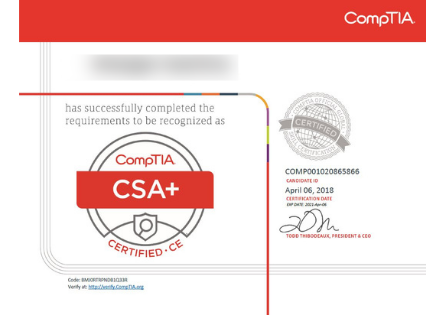
Trusted Cybersecurity Services. World-Class Training. Real-World Impact.
Train Your Team: Get Quote
The CompTIA CySA+ (Cybersecurity Analyst+) (CS0-003) certification training program from InfosecTrain focuses on cybersecurity’s technical and hands-on aspects, encompassing cyber threats, secure network architecture, risk management, log analysis, configuration assessments, and more. Upon successful completion, individuals are equipped with the necessary knowledge and skills to effectively identify, analyze, and interpret indicators of malicious activity. They gain a comprehensive understanding of threat intelligence and management, enabling them to respond to various attacks and vulnerabilities proactively. Additionally, candidates learn incident response methodologies to handle security incidents and mitigate their impact efficiently.

You'll receive an official certificate upon successful course completion.
The CompTIA Cybersecurity Analyst (CySA+) certification showcases your proficiency in utilizing behavioral analytics and detection techniques to spot and respond to cybersecurity threats. To earn the CySA+ certification, you’ll need to thoroughly understand the key topics covered in its body of knowledge, such as threat intelligence, data interpretation, and vulnerability management. CySA+ training offers a comprehensive approach to network monitoring, incident analysis, and the use of sophisticated threat detection tools. It equips professionals with the ability to mitigate risks, address vulnerabilities, and secure systems, applications, and networks. From detecting potential security breaches to implementing effective response protocols, the CySA+ certification ensures you have the expertise to defend an organization’s infrastructure against evolving threats.
Domain 1: Security Operations (33%)
Domain 2: Vulnerability Management (30%)
Domain 3: Incident Response Management (20%)
Domain 4: Reporting and Communication (17%)
| Exam Format | Performance Based & Multiple Choice |
| No. of Questions | 85 Questions |
| Exam Duration | 165 Minutes |
| Passing Score | 750 (on a scale of 100-900) |
| Languages | English, Japanese, Portuguese and Spanish to follow |
Join the next generation of security professionals with our industry-leading training programs
Unfilled positions projected by 2025 across all industries
Financial impact for organizations without proper security
Companies hiring our graduates
Our certified professionals are sought after by leading organizations
Organizations prioritizing cybersecurity training
Increased training budgets
High demand for security professionals
High demand for security professionals
High demand for security professionals
High demand for security professionals
High demand for security professionals
High demand for security professionals